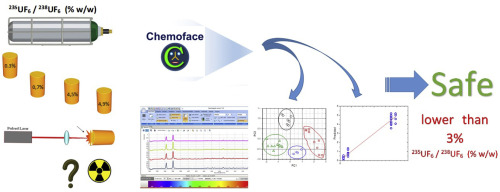当前位置:
X-MOL 学术
›
Spectrochim. Acta B. At. Spectrosc.
›
论文详情
Our official English website, www.x-mol.net, welcomes your feedback! (Note: you will need to create a separate account there.)
Isotopic analysis of uranium by laser induced breakdown spectroscopy
Spectrochimica Acta Part B: Atomic Spectroscopy ( IF 3.3 ) Pub Date : 2020-05-01 , DOI: 10.1016/j.sab.2020.105841 Carlos Rinaldi , Marcelo Pozzi , Norberto Boggio , Juan Vorobioff
Spectrochimica Acta Part B: Atomic Spectroscopy ( IF 3.3 ) Pub Date : 2020-05-01 , DOI: 10.1016/j.sab.2020.105841 Carlos Rinaldi , Marcelo Pozzi , Norberto Boggio , Juan Vorobioff

|
Abstract There are several advantages of using laser ablation (LA) for nuclear material detection, which includes minimal sample preparation, near-instantaneous detection, and isotope detection. The well-known laser ablation method commonly called Laser Induced Breakdown Spectroscopy (LIBS) has one of the main advantages of optical emission spectroscopy (OES): is noninvasive and near-instantaneous detection and identification of elements in the sample. The detection of special nuclear materials (SNMs), such as uranium and thorium, is of particular interest to many agencies around the world, i.e., International Atomic Energy Agency (IAEA). Chemometrics analysis coupled with LIBS is a suitable combination for the determination of isotope ratios in the air at atmospheric pressure using poorly resolved lines. Typically, the precision will be in the range from 4 to 10% depending on the enrichment level, which is compatible with the use of an alarm instrument in complementary access inspection.
中文翻译:

用激光诱导击穿光谱法分析铀的同位素
摘要 使用激光烧蚀 (LA) 进行核材料检测有几个优点,包括最少的样品制备、近乎瞬时的检测和同位素检测。众所周知的激光烧蚀方法通常称为激光诱导击穿光谱 (LIBS),它具有光学发射光谱 (OES) 的主要优点之一:可对样品中的元素进行无创且近乎瞬时的检测和识别。铀和钍等特殊核材料 (SNM) 的检测受到世界各地许多机构的特别关注,即国际原子能机构 (IAEA)。化学计量学分析与 LIBS 相结合,是使用解析度较差的谱线确定大气压力下空气中同位素比率的合适组合。通常,
更新日期:2020-05-01
中文翻译:

用激光诱导击穿光谱法分析铀的同位素
摘要 使用激光烧蚀 (LA) 进行核材料检测有几个优点,包括最少的样品制备、近乎瞬时的检测和同位素检测。众所周知的激光烧蚀方法通常称为激光诱导击穿光谱 (LIBS),它具有光学发射光谱 (OES) 的主要优点之一:可对样品中的元素进行无创且近乎瞬时的检测和识别。铀和钍等特殊核材料 (SNM) 的检测受到世界各地许多机构的特别关注,即国际原子能机构 (IAEA)。化学计量学分析与 LIBS 相结合,是使用解析度较差的谱线确定大气压力下空气中同位素比率的合适组合。通常,



























 京公网安备 11010802027423号
京公网安备 11010802027423号